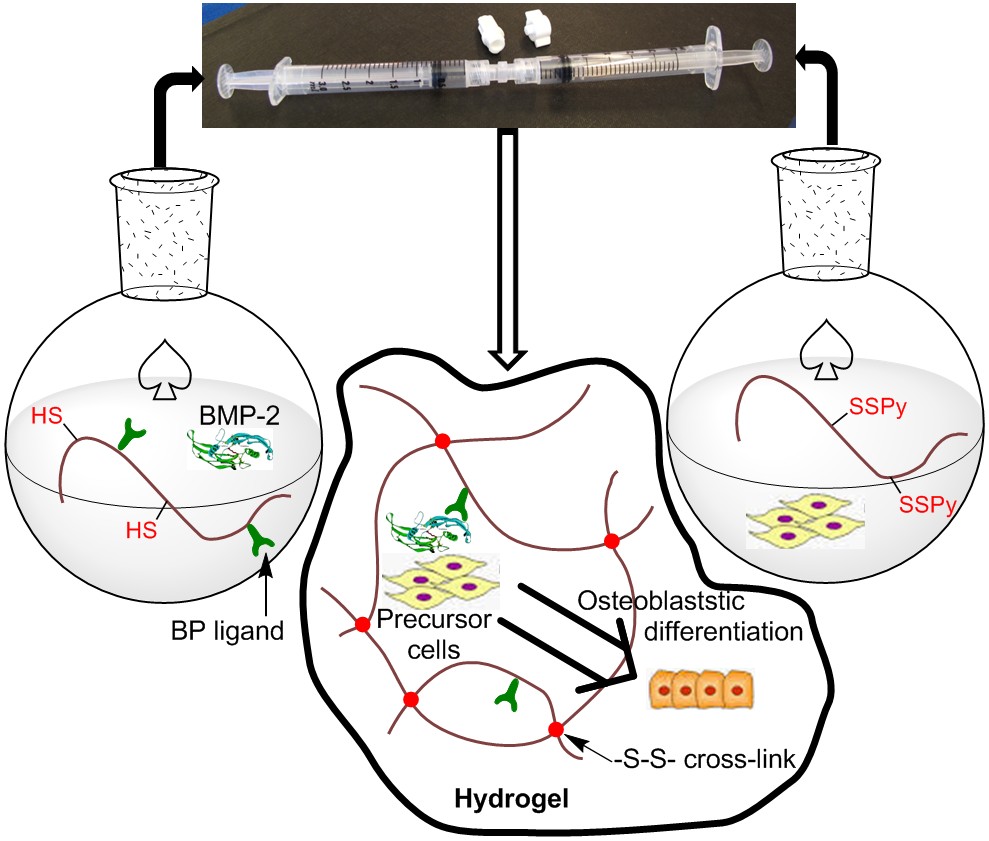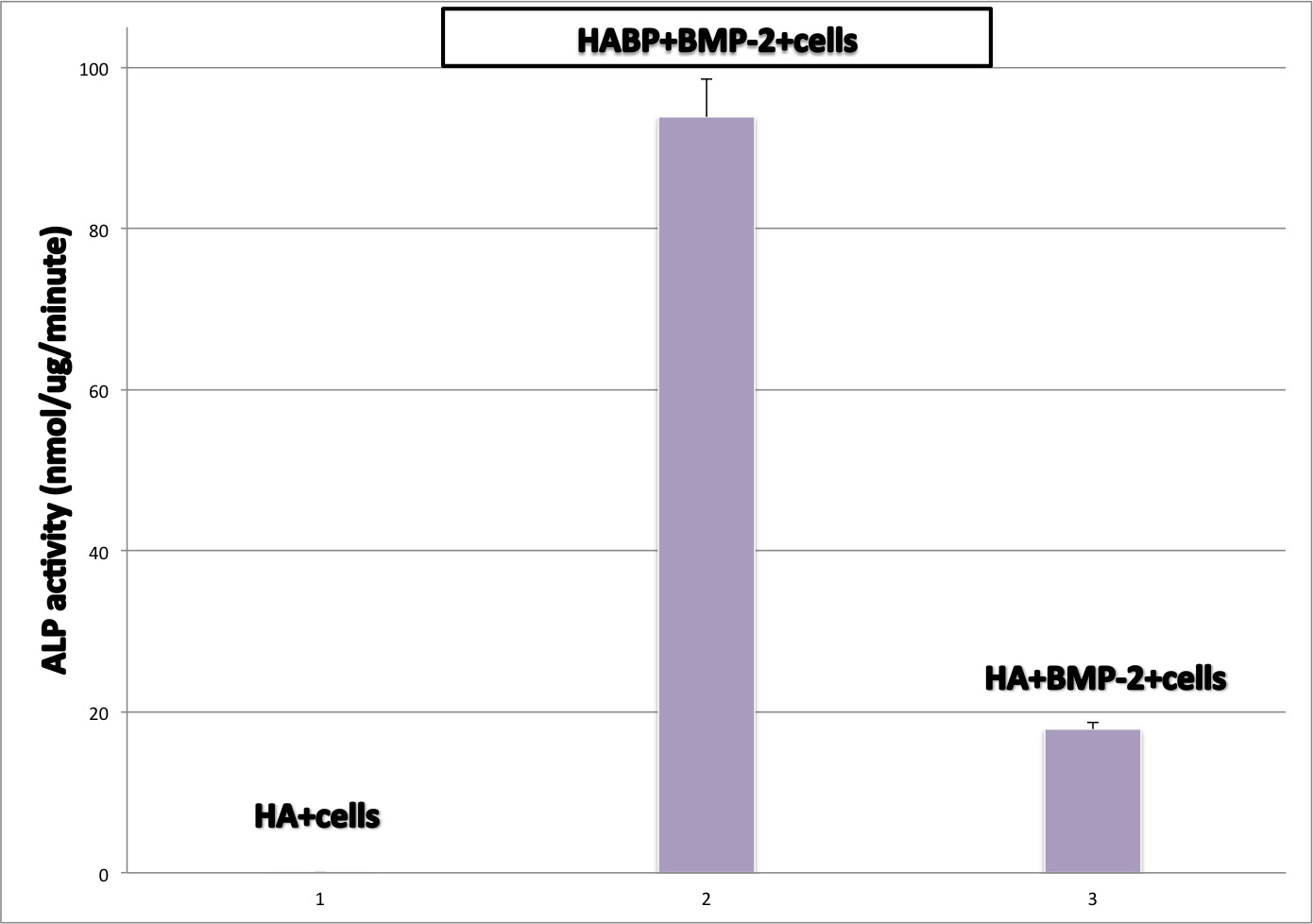Introduction: Repair or replacement of damaged tissues is often reliant on the ability of a biomaterial to control the delivery of growth factors[1]. Specific affinity interactions, which are engineered between the proteins and different matrices[2], exhibited capability to tune the rate of release while maintaining consistent levels of bioactivity. In this work we present an in situ cross-linkable hydrogel system that permits manipulation of entrapped cells in 3-D with the help of bisphosphonate (BP) ligands attached to the hyaluronic acid (HA) matrix and hence providing effective retention of bone morphogenetic protein-2 (BMP-2) in the matrix. Specifically, we demonstrate that (1) linking of predetermined amounts of BP ligands to HA matrix provide tailored degrees of BMP-2 release and that (2) BMP-2 sequestration caused by BPs provide a stable microenvironment for 3D entrapment of C2C12 myogenic progenitor cells in the hydrogel and promote their osteogenic differentiation (Fig. 1).

Fig. 1. In situ encapsulation of myotube forming cells and BMP-2 in hyaluronic acid hydrogel to induce 3D differentiation of the cells through the controlled retention and release of the growth factor by the matrix-linked bisphosphonate ligands.
Materials and Methods: HA-BP-SH derivative was synthesized by thiolation of the previously described HA-BP derivative[3] with 3,3'-dithiobis(propionic hydrazide).
Results and Discussion: Three HA derivatives carrying 2-dithiopyridyl (HA-SSPy), thiol (HA-SH), and bisphosphonate and thiol groups (HA-BP-SH) were prepared to form two types of hydrogels by thiol-disulfide exchange cross-linking reaction[3]. The hydrogels were in situ formed by mixing of either HA-SSPy and HA-SH (giving control HA network) or HA-SSPy and HA-BP-SH (giving bisphosphonated HABP network). In both hydrogels, HA chains were cross-linked by disulfide bonds and equal cross-linking density was ensured by the same degree of substitution with the functional groups in all three derivatives. Loading of BMP-2 into the hydrogels was achieved in situ by pre-dissolving the growth factor in HA-SSPy solution. We observed that the release of BMP-2 from HA hydrogel was faster than from the HABP matrix. Moreover, the rate of the growth factor release could be tuned by changing the amount of BP groups in the matrix which was easily achieved by combination of HA-SH and HA-BP-SH components at different mass ratios. Next, C2C12 cells were encapsulated in the hydrogels together with the equal amount of BMP-2 and the obtained constructs were cultured for 5 days. Expression of alkaline phosphatase (ALP), a major late-stage osteogenic differentiation marker, was then measured. A 5-fold increase in ALP expression was detected for the cells cultured 3-D in HABP hydrogels as compared to HA hydrogels (Fig. 2).

Fig. 2. ALP production by C2C12 cells cultured for 5 days in different hydrogels.
Basing on the release results, we propose that the cells were exposed to BMP-2 for longer time and at higher concentrations in HABP hydrogel than in HA hydrogel. The retention of BMP-2 in HABP hydrogel was attributed to BP groups that bind and protect the growth factor.
Conclusion: We present a novel hydrogel delivery system enabling sequestration of BMP-2 basing on use of in situ cross-linkable HA-BP conjugate. Application of this conjugate in combination with BMP-2 to cells in 3-D allows the cells to differentiate in osteogenic direction.
References:
[1] Hudalla, G. A.; Murphy, W. L. Adv. Funct. Mater. 2011, 21, 1754-1768.
[2] Vulic, K.; Shoichet, M. S. Biomacromolecules 2014, 15, 3867-3880
[3] Nejadnik, M. R.; Yang, X.; Bongio, M.; Alghamdi, H.; van den Beucken, J.; Huysmans, M.; Jansen, J.; Hilborn, J.; Ossipov, D.; Leeuwenburgh, S. C. G. Biomaterials, 2014, 35, 6918-6929
[4] Choh, S.-Y.; Cross, D.; Wang, C. Biomacromolecules 2011, 12, 1126-1136